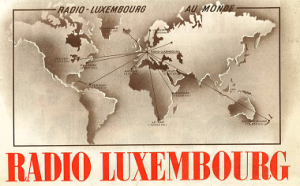
Author: Steve Engel
Unexpectedly powerful long waves began to be aired regularly in 1933. The waves emitted from three 180 meter high omnidirectional antenna pylons, installed at the transmitting station in Junglinster, reached audiences worldwide. But they also modified the earth’s ionosphere, creating interferences with other radio stations; a phenomenon called Luxembourg Effect.
The feeding system of the directional long wave antenna, formed by four 180 meter high pylons in 1939, multiplied risks of interferences and power rupture. A new more secure feeding system was build in 1952, increasing the range of the french listening area to 15 millions auditors by 1954.
The quality and range of the long waves further increased by coupling a new transmitter to the old one in 1954. Installing a new better oriented directional antenna, formed by two, then three, 250 meter high towers (215 since 1983) in 1955 and 1959, as well as a new transmitter in 1960, further helped reaching the french speaking audience; over 20 millions by 1963.
Since 1972, long waves were sent from a new more performant station in Beidweiler.
Contents
Sources:
| Eugène Muller, head of Radio and TV transmissions for RTL’s Broadcasting Center Europe, on the problems faced by the power consumption of long wave transmitters and the Luxembourg effect: |
Source: University of Luxembourg.
Literature:
“Antenna Terminology Defined.” Mobilemark.com (accessed on February 8, 2016).
Gust Graas, “Petite…et grande histoire de Radio-Télé-Luxembourg.” Les cahiers luxembourgeois. Radio-Télé Luxembourg (1961): 29-48.
“Il y a 80 ans, Radio Luxembourg s’adressait au monde sur ondes longues.” RTL Group.com, March 13, 2015 (accessed on February 8, 2016).
Raymond Mehlen (editor), Les cahiers Luxembourgeois. Numéro de Noël, Luxembourg 1954. (http://h-europe.uni.lu/wp-content/uploads/2016/02/00007.jpg; http://h-europe.uni.lu/wp-content/uploads/2016/02/Bio-Junglinster-2.jpg; http://h-europe.uni.lu/wp-content/uploads/2016/02/Bio-Junglinster-3.jpg).
“Les nouvelles installtion de Radio-Luxembourg et Télé-Luxembourg.” Le Haut-Parleur ,no. 968 (June 15, 1955): 7-9.
“Puissances de Radio-Télé-Luxembourg.” Les cahiers luxembourgeois. Radio-Télé Luxembourg (1961): 23-24.
“Radio. Luxembourg .” Luxemburger Wort, March 15, 1933 (accessed on February 8, 2016).
“Radio-Télé-Luxembourg, Poste de l’Europe. Au service du Marché Commun: 50 millions d’auditeurs”. Le monde diplomatique, February, 1963 (accessed on February 10, 2016).
Raymond Joly, “Miracles à Junglinster. La station émettrice”. Les cahiers luxembourgeois. Radio-Télé Luxembourg (1961): 68-79
Robert Tabuis, Au carrefour de l’Europe. Radio, Télé Luxembourg, Compagnie luxembourgeoise de Télédiffusion:Paris 1962.
Histoires de Sites…, Compagnie luxembourgeoise de Télédiffusion: 1996.
Author: Steve ENGEL
